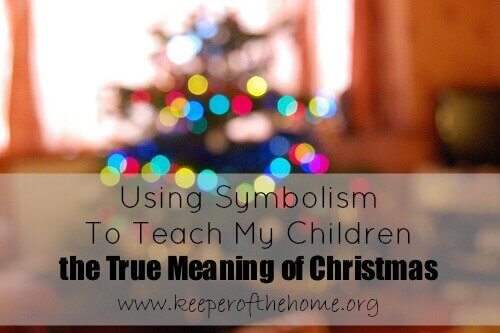Using Symbolism to Teach My Children the True Meaning of Christmas
Guest post by Beth of Red & Honey
“After they had heard the king, they went on their way, and the star they had seen when it rose went ahead of them until it stopped over the place where the child was. When they saw the star, they were overjoyed. On coming to the house, they saw the child with his mother Mary, and they bowed down and worshiped him. Then they opened their treasures and presented him with gifts of gold, frankincense and myrrh.” Matt.2:9-11 NIV
What is the True Meaning of Christmas?
Real or artificial? The great Christmas tree debate is alive and well every year, but for my family, it simply must be a real tree.
Every year we would brave the cold and snow to go pick out a Christmas tree. It was always a big production to bring it home, saw off the end, stand it up straight in the base.
“A little to the left! No, now right… hmm, try turning it around 180 degrees,” my mother would say, as my father muttered on his hands and knees, getting poked with branches and pine needles.
One year my mom said she’d had it with vacuuming up pine needles until spring, and that she found an artificial tree on clearance. We set it up, looked at each other aghast, and promptly headed out to the car, straight for the tree farm down the road. Never again, we swore.
We’d decorate the tree with little hardened salt-dough stars and cotton-ball sheep made in Sunday School. My Mom told us the story about the candy cane, and how it reminded us of a shepherd’s staff, just like Jesus the Good Shepherd who knows our names.
The rich and deeply spiritual symbolism of Christmas was a significant part of my upbringing and spiritual shaping. I am now blessed with the opportunity to share these traditions with my children, as we set them on a foundation of faith and understanding of the true meaning of our celebrations at Christmas.
I understand that some people have differing opinions on how we should celebrate Christmas (or if we should even celebrate it at all!) Some claim that the supposed pagan history of many Christmas symbols and traditions mean that Christians should reject them.
Is this true? What do these traditions really mean?
Symbolism is everywhere in our world. It is a largely cultural phenomenon whereby cultures ascribe meaning to otherwise benign objects and practices. Part of the fun of Christmas, for me, is the deep spiritual meaning that is involved in our traditions.
A symbol’s meaning can evolve or change based on its current usage in culture, which means that even if an evergreen tree was once used by pagans in sun-worship, it does not mean that Christians today cannot use it to remember Emmanuel, the Everlasting Father, the Prince of Peace!

Image by Matthias Rhomberg
My faith comes alive in those evergreen branches that symbolize everlasting life and hope in Christ, and my hope is renewed by a simple star on top of our tree that reminds me of the night my Savior was born.
An amoral thing like a tree cannot be good or evil in and of itself, and if I chop down an evergreen tree, haul it into my living room, top it with a star and decorate it with lights, I am not participating in pagan tradition, I am teaching my children about the death and resurrection of our Lord and Saviour (the tree was chopped down and then erected again). I am teaching them about the Christmas story (the star that led the Wise Men) and about the hope that we have in the darkness through Jesus, the light of the world (those twinkling lights).
When we thoughtfully choose gifts to give our loved ones and present them on Christmas morning in an act of love, we are remembering the precious gifts given to a King born in a manger.
Even Santa can be used to teach children about a spirit of generosity through the story of St. Nicholas. He can also be a parable of the delight and mystery of life in Christ. Though we don’t personally “do” the Santa thing in our house, I believe that Christian families can choose to participated in it well, always pointing back to Christ in the end.

In our family, we have decided that we will teach our children the symbolism of Christmas and that all of it ultimately orients our hearts in worship toward the babe in the manger.
The angels, the candles, the wreaths, the bells… all of it is an opportunity to remind myself and to show my children the beginning of the mystery of God Incarnate when Love came to earth wrapped as a baby.
This is the wonder and magic of Christmas, and at our house, it starts with the annual trudging through an evergreen lot to find the perfect Christmas tree.
So, you tell me: real or artificial?





Beth, this is the BEST post I’ve ever read about Christmas symbolism. Well done.
Stacy, THANK-YOU for making *this* my first comment ever on a guest post here at KOTH… I am honoured by your words, and I am so glad you liked it! 🙂
Thank you for this post! I am so tired of “Christians” who want to take away the joy by arguing about “origins”. Personally, I do not believe Holy G-d has any part in this attitude or behavior.
As our world continues on its quite-predictable course, I think it is an imperative that we grab a smile, a laugh, a bit of joy, wherever we can find it – and it will become even more so as the days move forward, darker and more evil (it’s all in His Word).
I remember the year I worked briefly in a Christian day care center, taking care of 3-year-old children. I did not know it was a “no-no” to discuss Santa, and so I read them, “The Night Before Christmas”, at which point one 3-year old screamed out, “Santa is the devil!”, which made 2 little boys cry uncontrollably, and they were STILL crying when the parents showed up! Now, I know what the little boy was told, or, at least I think I do, but the 3-year-old did not have the cognitive ability to separate the parents’ intent from the truth. The damage those well-intentioned but misguided Christian parents did is probably never going to be fully measurable, IMHO.
Our favorite Christmas decoration, and the only one we have out this year (just being honest) is our figurine of Santa kneeling over the baby Jesus in a Manger, praying. We like it so much, in fact, we leave it out year around! : )
Again, I thank you for having the courage and the conviction to post this message. Blessings to you, and all that is yours. May you continue to be a shining light in the darkness!
Glad you enjoyed it, Elizabeth!
I agree that this is the best post I’ve ever read about Christmas symbolism! We are a “real tree family”! I LOVE the idea that the tree represents Jesus’ death and resurrection… that’s beautiful! Thanks for some great ideas! Merry Christmas to you and your family!
Thank-you Christina! Your words are too kind 🙂 Merry Christmas to you as well!
We use the Advent calendar to count down to Christmas, ours is the type that tells the story leading up to and of the birth of Jesus. I LOVE that!
I love advent too, especially now as an adult.
I appreciate Keeper of the Home and have learned so much from this blog! I have a few challenging thoughts about this post because I yearn to hear God’s Truth proclaimed plainly, not hidden in confusing symbolism…
“[Symbolism] is a largely cultural phenomenon whereby cultures ascribe meaning to otherwise benign objects and practices.” …isn’t that called IDOLATRY or at best ICON WORSHIP? What is cultural, is often not Biblical. Of course in the Old Testament you’ll find what you might call some “symbolic” practices for the Jews (temple, sacrifices, alters) but these were SPECIFICALLY PRESCRIBED BY GOD and were pictures of things to come that were fulfilled through Christ. We would be denying Christ to revert back to worshiping these symbols now that we know the SAVIOR. In the New Testament you can find baptism and communion as “symbolic-type” practices, but again, these were given directly from God. However, the practice of worshiping the evergreen tree is specifically denounced by God in Jer 10:2-4. So why would we turn it in to something that we say we use to worship God? Perhaps it’s just our fleshly lust for the warm, fuzzy, special memories? I want to teach my children to err on the side being Biblical, not symbolic, and to worship the Savior directly instead of through inanimate objects. I, too, want to teach my children about the “mystery of God incarnate” but I can think of a much clearer way than “the candles, the wreaths, and the bells.” I’ll just use the Bible!
Hi Alison, thanks for taking the time to comment. I want to just address a few things that I think you misunderstood in my post.
1) I think you are not quite understanding the meaning of “symbolism”. It has nothing to do with icons and idolatry. It is simply the idea or meaning behind an object or practice. A stop sign is an example of a symbol. We all know what that red octagon means because it is a symbol in our culture. Even without the word on it, we’d all still recognize it. Another example is the sign on the door of a public washroom – a stick figure male and female. These are symbols. Using a Christmas tree to symbolize the resurrected Christ does not mean we are engaging in idolatry of trees any more than using a washroom male/female sign is engaging in idolatry of toilets.
2) Nowhere did I suggest worshipping the tree, the angels, the bells, the lights, or anything but God himself. I apologize if that was unclear!
Thanks for sharing your thoughts.
Thanks for thinking about my comment and replying. I did not mean to suggest that you worship the tree or the lights. I could tell that from your post. It is clear that you want to use these as teaching tools and symbols that point to God. I do not think I misunderstand you.
I agree that hanging a cross on your wall or having a Bible verse on your nightstand could be a beneficial symbol to help remind us of what Christ has done for us. But why would you decorate an evergreen tree when it is clearly denounced in the Bible (Have you read Jeremiah 10:2-4?)? How is that different from putting a golden calf on display in your home and saying it symbolizes God’s strength and provision for us? You wouldn’t! If you felt you needed a symbol, you wouldn’t pick something that the pagans used to worship their gods! I know that historians do not always agree on the origins of the Christmas tree but when the Bible says “Learn not the way of the heathen… For the customs of the people are vain: for one cutteth a tree out of the forest… They deck it with silver and with gold; they fasten it with nails and with hammers, that it move not. (Jer 10:2-4)” I cannot deny that the Word of Truth directly identifies this as heathen and VAIN. Why would we then choose this symbol to glorify him?
If our true intent is to celebrate the gift of grace and eternal life only made possible by the blood of Jesus Christ, why would we hide that behind symbols of evergreen trees, lights, and angels. And if the tree and lights really are helpful symbols for you and your children, why don’t you leave them up all year round? I think it’s damaging to the faith of our children to place more emphasis on Christ’s birth and death at certain times of the year. God never instructs us to do this in the Bible. Why do we do it?
I would challenge “thinking Christians,” like you and I, to question why we are so ready to conform to this pattern of the world and so offended at the thought of Christmas with no tree!
Alison, I’m not looking to get into a huge debate, but I have heard the argument before that if ‘heathens’ used something,then we as Christians are not to use it. Does that mean that we are never to sing, dance, act, paint again? Those arts have all been greatly misused. I think of how there are examples of dance in the Bible that are heathen/idolatrous and those that are used in the exuberant/joyful praise of the Lord (dance of Salome vs the dance of King David). By saying that something has been used by ‘heathens’ and we are to never use it, that downplays the power of the blood of Jesus and His redemptive work on the Cross. Of course, nothing is ever to get in the way of our seeing Jesus first and foremost, but He himself used signs and symbols in His teaching. I won’t get into your statement that you “think it’s damaging to…place more emphasis on Christ’s birth and death at certain times of the year…etc”, I would just point out that God did set up the 7 Jewish feasts and that Christ has fulfilled all of them. Perhaps we should celebrate those as Jewish people have done for hundreds of years and thus point the way to the Messiah who came for all.
I love your thoughtful intention about Christmas. So lovely.
I had thought quiet this much about the symbolism. Thanks for giving me something to mull over this morning.
Thanks Stacy, glad you enjoyed it!
I loved your story about how your mom had had it with vacuuming up the needles. My mom bought us a really pretty pre-lit artificial tree eight years ago. We have gone back and forth through the years, but for the last two have had a real tree. Well, this year I decided we’d use the artificial one. My husband put it up, the kids decorated it, and I was so bummed. I told my husband that we wouldn’t be using it again. Last week he surprised us and came home with a real tree! We transferred all the ornaments over and it is soo much prettier. Everyday I have told my dear husband what a great Christmas present that was for me.
Haha! There are some definite similarities in our stories 🙂 When you’ve got the “real-tree-love”, an artificial one is just not gonna cut it!
Great post Beth! One of my favourites of yours that I’ve read.
Thanks for sharing this post. I plan on retelling this to my dd. This is beautiful way to talk about Jesus’ sacrifice for our sins.